1. Objective
The emissions of wood-burning stoves and pellet stoves has been much in the news in recent years. It is said that wood-burning stoves emit a lot of particulate matter and pellet stoves actually emit a lot of ultra-fine particles. However, very few publications can be found where ultrafine particles have been measured. We had the idea of measuring ultra-fine particles ourselves which has now become possible (using an ultra-fine particle monitor). In this blog we describe our results and experiences gained during a day of measuring on an unique location.
2. Ultra-fine particles
Ultrafine particles (UFP) are the smallest particles in the air with a diameter from a few nanometers to 0.1 micrometer (<0.1µm). These particles are so small that after inhalation they end up directly in your bloodstream and can cause damage throughout your body.
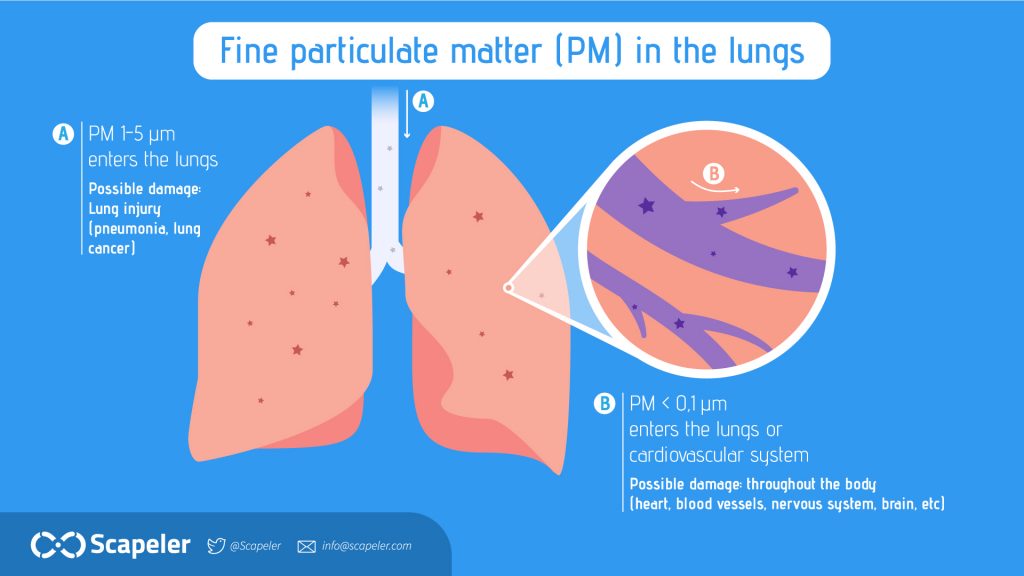
3. Method
3.1 Ultra-fine particle monitor
We measured the concentration of UFP with the CPC 3007 from TSI. CPC stands for condensation particle counter. The monitor uses iso-propyl-alcohol to solvate the UFP particles so that they become large enough to be measured by the laser. The monitor measures the total number of UFP particles with a diameter of 10 nanometers to 1 micrometer. The unit of UFP concentration is particles/cm3. The linear operating range is up to 100,000 particles/cm3.
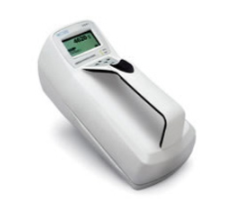
3.2 Measuring location
We have been able to find a measuring location where we can measure wood-burning stoves and pellet stoves. The measurements can be taken in the living room, but also at the outlet of the chimney. It is possible to measure different types of stoves at this measuring location. In this instance we opted for a computer-controlled pellet stove from 2019 and a traditional wood-burning stove from 2015 (a non ECO-design model).
4. Results & Discussion
4.1 Pellet stove
In the first instance, we measured UFP at a computer controlled pellet stove in the living room. After starting the pellet stove, the concentration of UFP in the living room was monitored for half an hour. The measurement was carried out at a distance of 3 meters in front of the pellet stove in a living room of 25 m2. After starting the pellet stove, smoke was visible in the combustion chamber. This smoke partially entered the living room and caused a temporary increase in the UFP concentration of approximately 11000 to 19000 particles/cm3, following that the UFP concentration remained between 9000 and 13000 particles/cm3.
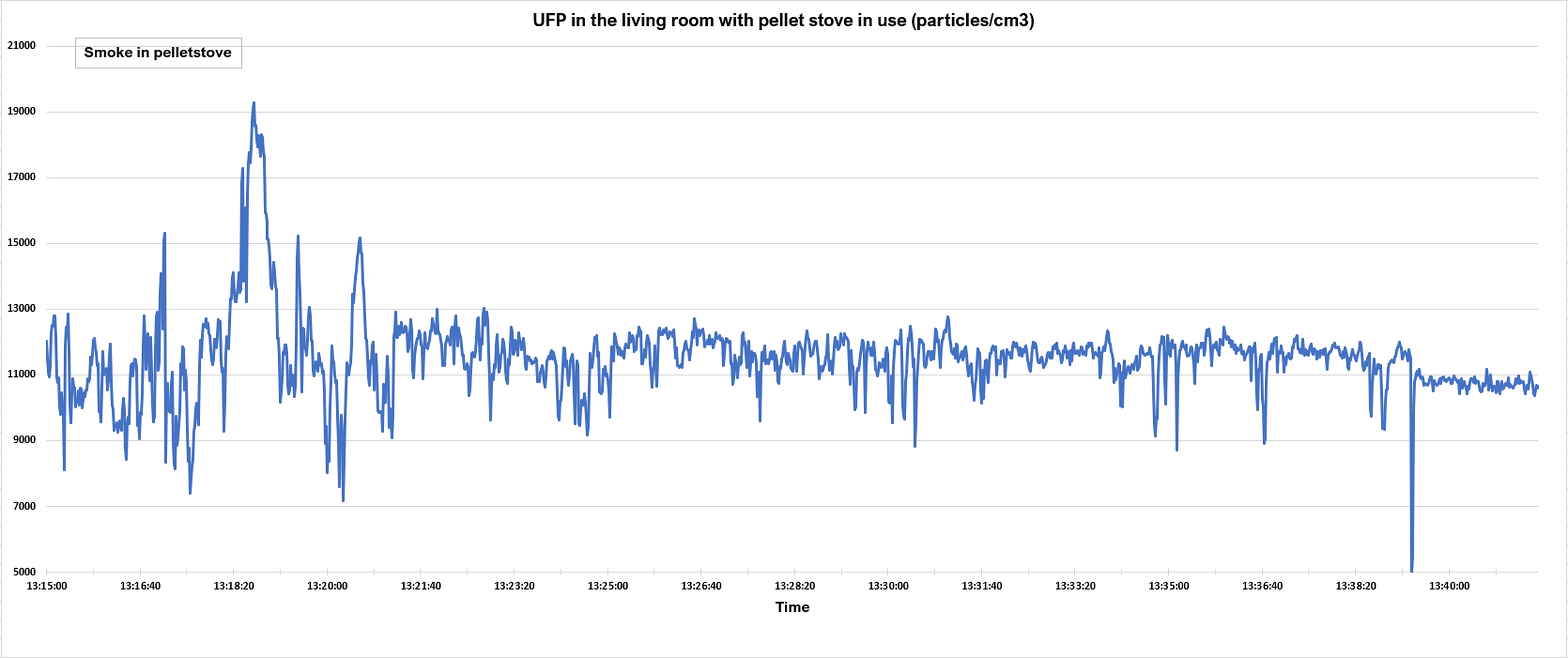
Following the indoor measurement, the UFP concentration was measured at the outlet of the chimney at a distance of 25 cm. The outside UFP concentration of the clean air was approximately 7500 particles/cm3. The measurement at the chimney showed that peak values in the UFP concentration went up to almost 600,000 particles/cm3! These are extremely high values and are far above the linear operating range of the UFP monitor. The true values could even be higher. According to the Dutch National Institute for Health and the Environment, a concentration of 100,000 particles/cm3 should be considered as an extreme value and is achieved, for example, at a very busy motorway in a large city.
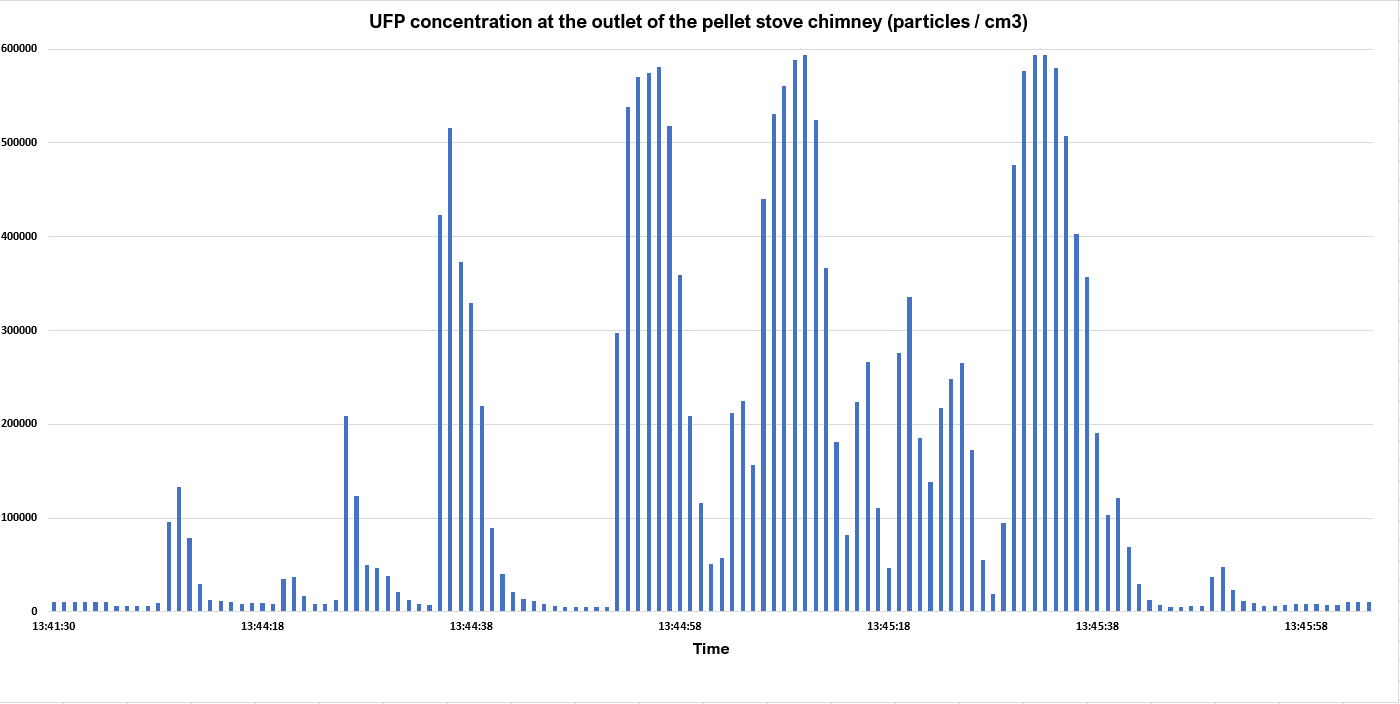
4.2 Wood stove
After the pellet stove it was it was now the turn of the wood stove. The wood stove is an 8 kilowatt model from 2015. Before we started the measurement on the wood stove, we ventilated the living room by opening two windows and waiting for the UFP concentration to stabilize to the background level.
The wood stove was started according to the Swiss heating method. After two logs have been added to the fire, the UFP concentration in the living room started to increase considerably. The fire became so hot that the air supply to the combustion chamber was needed to be reduced. From that moment on, the UFP concentration increased further to around 150,000 particles/cm3. After 15 minutes two more logs were added to the fire. The catalytic afterburner ABCAT was then switched on and from that moment no more logs were added to the fire. We stopped measurement in the living room for half an hour in order to carry out measurements at the chimney outlet of the wood stove. After the measurement at the chimney was finished, it was resumed in the living room.
During the burning out of the wood stove, the UFP concentration increased to a maximum of 325,000 particles/cm3. This is again an extremely high concentration. It became so hot in the living room that we decided to open two windows fully to ventilate. During ventilation, the UFP concentration slowly dropped back to the background level. The wood burning stove was not yet burnt out, a glowing ash residue was still visible.
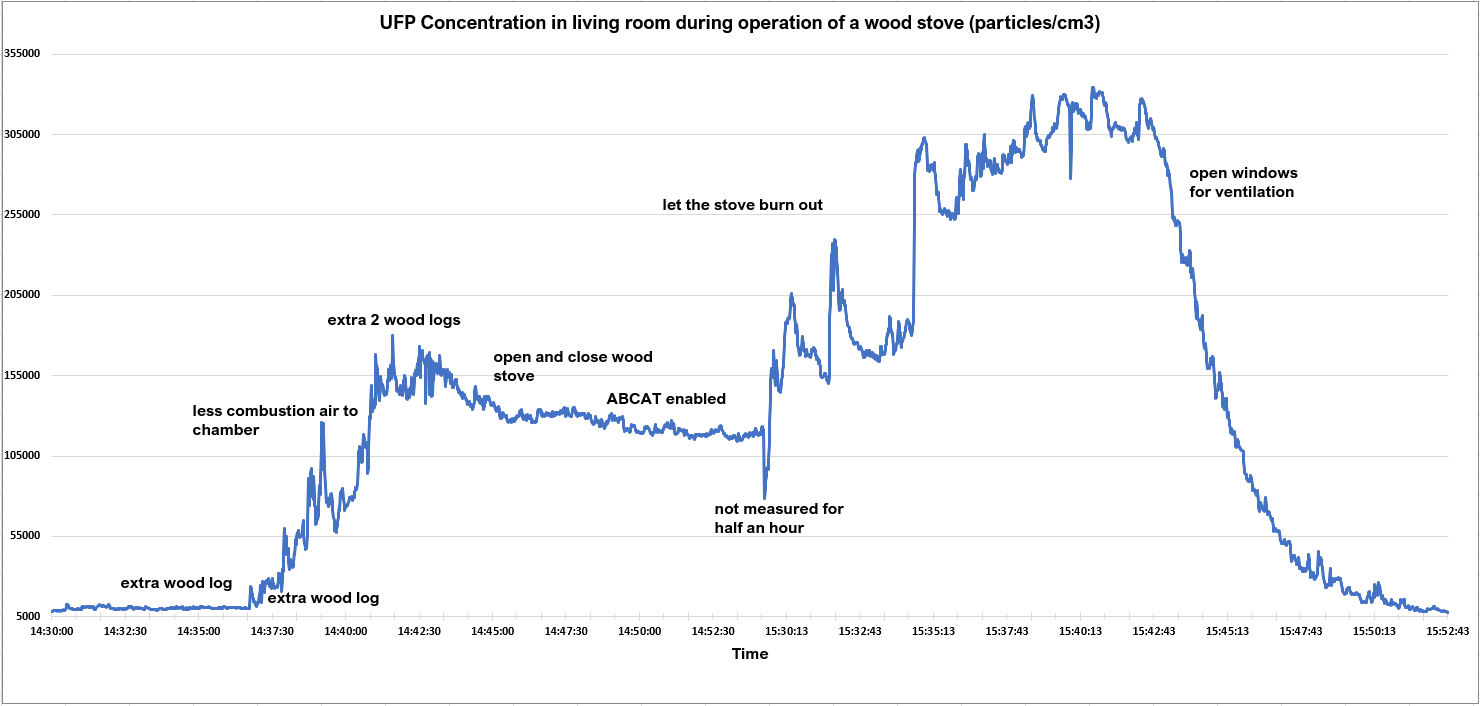
Just like with the pellet stove, we also measured UFP at the chimney of the wood stove. We also tested the effect of different types of catalytic filters. The measurement was performed at a distance of 25 cm from the outlet of the chimney.
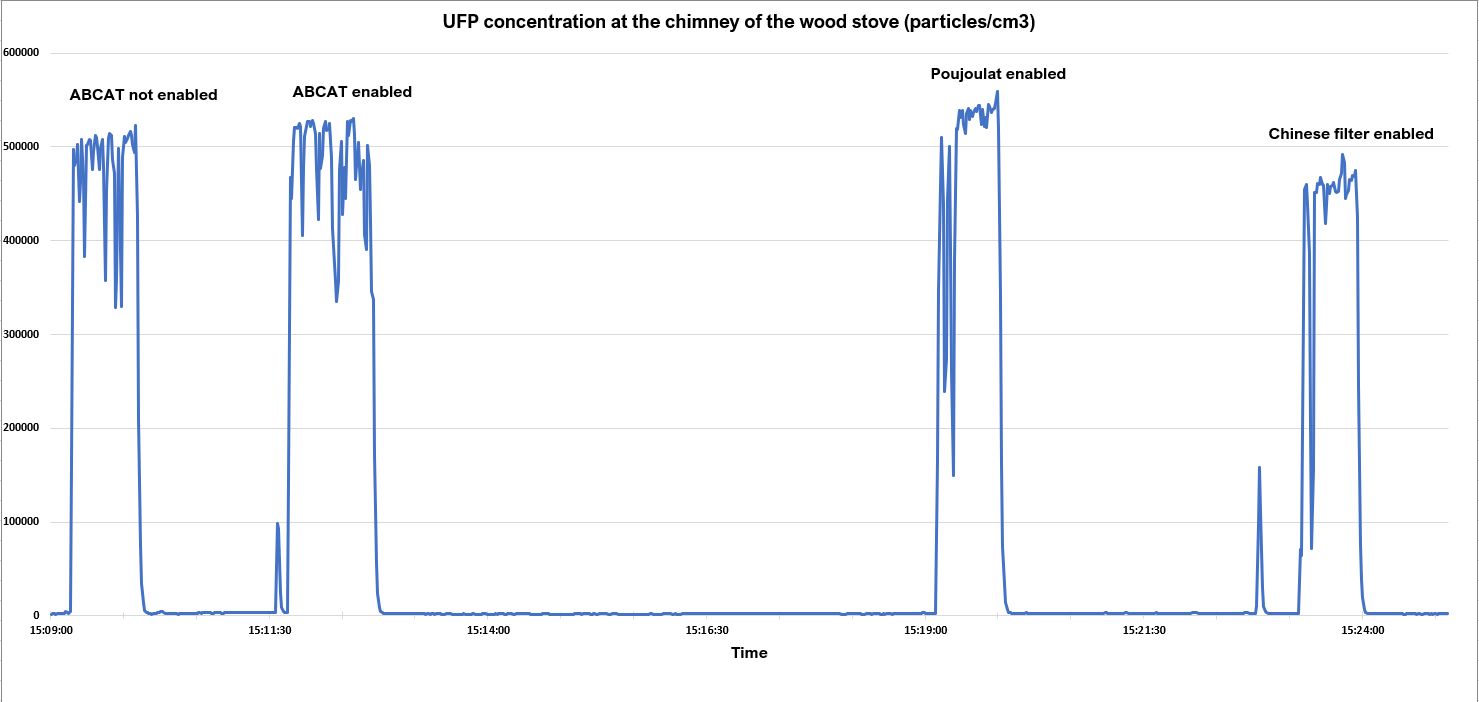
The UFP concentration without catalyst was at a maximum of 505,000 particles/cm3. With the first catalyst switched on, the concentration increased to a maximum of 525,000 particles/cm3. With the second catalyst, the concentration increased to a maximum of 560,000 particles/cm3. With the third catalyst, the concentration increased to a maximum of 490,000 particles/cm3. The measured values at the chimney of the wood stove are comparable with the values measured at the chimney of the pellet stove. All measured values are extremely high. It appears that the catalytic filter further increases the concentration of UFP. The third filter caused more resistance in the flue gas channel, so that the UFP concentration was less high compared to the other filters.
5. Conclusion
We were extremely surprised by the measurement results from this first experiment. We expected that we would measure high UFP concentrations but we certainly did not expect that the levels recorded in the living room would be so high, we were shocked. The plan is to repeat this experiment with other types of pellet stoves and wood stoves. We hope to be able to measure on a modern ECO design wood stove next time. Our story continues!







Deze metingen komen min of meer overeen met de gegevens in A Danish Case Study:
Measurement of ultrafine particles
The Danish Ecological Council has
carried out several measurements of
ultrafine particles from wood burning. Some of the measurements were
made in the mixing zone in the top
of a chimney from a modern eco-labelled wood stove (Nordic Swan-label) from 2011 connected to a new
chimney. Ultrafine particles were
measured with a P-Trak (Model 8525
Ultrafine Particle Counter). To avoid
direct sooting of the P-Trak and to allow cooling of the smoke a two-meter-long tube was inserted between
the chimney and the P-Trak. The tube
adsorbs approximately 30% of the
particles
The measurements were made
under ideal operational conditions,
i.e. good air intake and small pieces of completely dry wood (10-12%
humidity) stacked in alternating
directions in the stove. A total of
1kg of wood was used. The fire was
started from the top with two small
ethanol kindling blocks. The fire
started quickly and had clear yellow
flames.
The measurement results are shown
in figure 3. It is seen that even under
optimal firing conditions in a good
eco-labelled wood stove, particle
emissions increase instantaneously to
the maximum limit of the measurement equipment of 650,000 particles
per cm3 (corrected for removal of
30% in the probing tube). Only at
moments with wind (clean air) entering the mixing zone in the top of the
chimney the particle level was briefly
registered below the measurement
limit. Therefore, in reality emissions
was markedly higher than what the
P-Trak was able to measure and
thereby significantly higher than illustrated in the figure where the curve
merely flattens at the exceedances of
the measurement limit. Afterwards,
sawdust briquettes were used for
firing (1 kilogram), and this led to a
lower, but still very high, level of emissions of ultrafine particles. For comparison, the pollution was measured
in the garden of the house (windward
side without smoke impact) and in a
forest area near the house.
Sooted
tube
New
tube
After an hour of
measurements the tub
Reacties zijn gesloten.